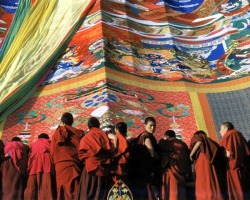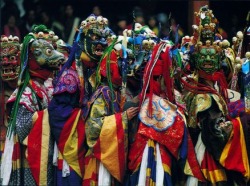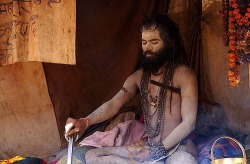Cultural Touring in Himalaya.
Kinnaur
Kinnaur, the north – east frontier district of Himachal pradesh is a secluded region rugged and mountainous and lies on both the banks of the river satluj. It commands uniqueness on account of peculiarities of language, history and nature phenomenon. The inhabitants of kinnaur trace back their history to mahabharata time it was once a pass of the bushar state. Epics have described kinnaur as great musicians who lived in the high Himalayas. It is said that the pandavas had learnt music and dance from them when they spend some time here during the exile. But this region went through many transformations in the 13th & 14th centuries, when some outsiders like Aryans of the Vedic times and khasgis from ladakh area ruled it. Ultimately the thakurs established their hold, which is reflected in their big forts and palaces. Majorities of kinnauri are of the Aryan race but some have mongoloid features that are living along the border of Tibet. Their religion is the mixture of Hinduism and Buddhism but the lamas have great influence on their daily lives. In general, practice, they believe in demon worship and almost every village has its own local deity. These are chortens erected in every village.
Festivals: - Festival of flowers: is celebrated in the month of august- September and October. Various kinds of flowers are used in this festival.
Chatrol: - It is celebrated in the month of March – April.
Dukhrain: - This singing and merry making festival is celebrated in the month of July – August.
Saza & phagul: - It is celebrated in the month of January.
Temples:- there are various temples in kinnaur valley. Some of them being the temple dedicated to god nagesh in the sangla valley, three temples of local goddess mathi, in chitkul is about 500 years old, goddess shuwang chandika temple in kothi an the temple of jamato in Leo. Three Buddhist monasteries dedicated to galdang in choiker, dunguir & Kangyur, lagang temple in nako.
Lahaul and Spiti valley: -
Lahaul - With its beautiful side valleys, is a massive trough that divides the great Himalaya and pir panjal ranges. This is a typical Himalayan alpine area as high summits surrounds the valley and along the track lies massive moraines and glaciers. Its inhabitants, a mixture of Buddhists and Hindus, enjoy one of the highest per capita incomes in the subcontinents. Using glacial water channeled down the mountains through ancient irrigation ducts, lahauli farmers manage to coax a bumper crop of seed potatoes and peas. Lahaul generally used as a transit point to ladakh, is a very interesting destination for tourists. The monasteries of guru gantal, kardang, shesur in bhaga valley and temple and monastery of trilokinath and Udaipur are worth visiting.
Spiti - As Kipling describes in his famous saga, Kim "Surely the Gods live here, this is no place for human". The Spiti Valley may be one of such rare pockets where one can trace a continuous course of the development of Lamaism from its very primitive form of the days of the Padmasambhava, when it had more of the Bon - Pa overtone, to its latest version, the Ge-lug-pa. In Spiti, where faith is as deep as the rivers swift has an introversive culture of life focused around its several monasteries - Dhankar, Kye, Tabo, to name a few.
Fairs and festivals: - losar and gyalto are celebrated in November – December, to say goodbye to the old year. Other festivals are thon, lapsol, and namkhar of the New Year. Gutor is held in every gompa. Kangra and Chamba - Town of Temples and History
Kangra Valley is one of the Himachal’s beautiful valleys. It rolls down the Southern edge of magnificent Dhauladhar Range in gentle slopes covered with forests of Pine, green tea gardens terraces fields. The Dhauladhar – The “White Range” rises up to 14000 ft. providing a dramatic backdrop to the hill resort of Dharmshala. His Holiness, the Dalai Lama resides here in Macleodganj, which is now a major center for Tibetan Government in exile and Tibetan culture. It has a school for Tibetan studies with rare manuscripts and ancient texts, Tibetan Institute of Performing Arts and a handicrafts center Dharmshala has everything for a perfect holiday . Many ancient temples like, Masroor, Jwalamukhi, Bajreshwari, Chamunda and Baijnath ( Vaidyanath) lie on the plains below Dhauladhar.
Zanskar :- Its centuries of isolation with outside World and inaccessibility is reflected in its own introversive and unique culture. The old medieval system, “back of ponies” is the medium of transportation even now .
Zanskar, which means “white Copper” in the native language, is unlike anywhere else - Mysterious whistle of the wind, fluttering prayer flags on the gompa roofs, buzzing sound of the prayers from monasteries. The frighteningly beautiful landscape dominated by numerous shades of brown and red of the majestic high Mountain desert, mesmerizes all travelers by its unique Himalayan aura. Dotting the entire expansive landscape are, the tiny villages surrounded by the paddy fields, inhabited by courteous and friendly people. Unlike Suru Valley, which has Shia Muslim population, Zanskar valley is predominantly Buddhist. Monasteries of Phuktal, Karsha, Zonkhal, Sani and Zangla are unmatched in their unique architectural beauty and wealth of old thankas and paintings. These monasteries are the nucleus of social, spiritual, cultural, political and economical life of Zanskari folks
Ladakh – Last outpost of Tibetan civilization
Ladakh, the highest and the most extensive Himalayan region sandwiched between two vast mountain systems, the Himalayas to the south, the Karakoram to the north and beyond Karakoram lies another mountain Range, Kun - Lun. With its borders with Tibet, Chinese Sinkiang and Baltistan, Its location has earned Ladakh the nickname “Central Asian Diamond,” which brought the various realms of Asia together through certain important trade routes connecting lands lying on all its four sides. Ladakh served as a transit area, a region of interaction for people from neighboring regions.
Ladakh is divided into different interesting valleys; Zanskar to the south, Suru valley in the south West, Nubra Valley to the northeast, Markha Valley in the center and Rupshu to southeast. The major rivers of the region are Zanskar, Suru, Indus, Markha, and Shayok. Most of these trails for trekking and other travels always have a river, as a companion so during the travels in Ladakh, it is also interesting to connect our journeys with these rivers, along which flourished some of the great civilizations of the World.
These Valleys offers an amazing variety of ingredients for the travelers in terms of the ancient culture endowing it with the mystery as the result of centuries of isolation, its lunar landscape with beautiful monasteries constructed at the highest and isolated points on the rocky mountains and strikingly beautiful brackish lakes such as Pangong Tso, Tso Moriri, and Tso Kar.
The multi racial society is the result of intermingling of various ethnic groups such as Dards, Tibetans and possibly other races too.
It is also regarded as the last outpost of Tibetan civilization. Buddhist population dominates Ladakh and other religions preached being Islam.
Kinnaur, the north – east frontier district of Himachal pradesh is a secluded region rugged and mountainous and lies on both the banks of the river satluj. It commands uniqueness on account of peculiarities of language, history and nature phenomenon. The inhabitants of kinnaur trace back their history to mahabharata time it was once a pass of the bushar state. Epics have described kinnaur as great musicians who lived in the high Himalayas. It is said that the pandavas had learnt music and dance from them when they spend some time here during the exile. But this region went through many transformations in the 13th & 14th centuries, when some outsiders like Aryans of the Vedic times and khasgis from ladakh area ruled it. Ultimately the thakurs established their hold, which is reflected in their big forts and palaces. Majorities of kinnauri are of the Aryan race but some have mongoloid features that are living along the border of Tibet. Their religion is the mixture of Hinduism and Buddhism but the lamas have great influence on their daily lives. In general, practice, they believe in demon worship and almost every village has its own local deity. These are chortens erected in every village.
Festivals: - Festival of flowers: is celebrated in the month of august- September and October. Various kinds of flowers are used in this festival.
Chatrol: - It is celebrated in the month of March – April.
Dukhrain: - This singing and merry making festival is celebrated in the month of July – August.
Saza & phagul: - It is celebrated in the month of January.
Temples:- there are various temples in kinnaur valley. Some of them being the temple dedicated to god nagesh in the sangla valley, three temples of local goddess mathi, in chitkul is about 500 years old, goddess shuwang chandika temple in kothi an the temple of jamato in Leo. Three Buddhist monasteries dedicated to galdang in choiker, dunguir & Kangyur, lagang temple in nako.
Lahaul and Spiti valley: -
Lahaul - With its beautiful side valleys, is a massive trough that divides the great Himalaya and pir panjal ranges. This is a typical Himalayan alpine area as high summits surrounds the valley and along the track lies massive moraines and glaciers. Its inhabitants, a mixture of Buddhists and Hindus, enjoy one of the highest per capita incomes in the subcontinents. Using glacial water channeled down the mountains through ancient irrigation ducts, lahauli farmers manage to coax a bumper crop of seed potatoes and peas. Lahaul generally used as a transit point to ladakh, is a very interesting destination for tourists. The monasteries of guru gantal, kardang, shesur in bhaga valley and temple and monastery of trilokinath and Udaipur are worth visiting.
Spiti - As Kipling describes in his famous saga, Kim "Surely the Gods live here, this is no place for human". The Spiti Valley may be one of such rare pockets where one can trace a continuous course of the development of Lamaism from its very primitive form of the days of the Padmasambhava, when it had more of the Bon - Pa overtone, to its latest version, the Ge-lug-pa. In Spiti, where faith is as deep as the rivers swift has an introversive culture of life focused around its several monasteries - Dhankar, Kye, Tabo, to name a few.
Fairs and festivals: - losar and gyalto are celebrated in November – December, to say goodbye to the old year. Other festivals are thon, lapsol, and namkhar of the New Year. Gutor is held in every gompa. Kangra and Chamba - Town of Temples and History
Kangra Valley is one of the Himachal’s beautiful valleys. It rolls down the Southern edge of magnificent Dhauladhar Range in gentle slopes covered with forests of Pine, green tea gardens terraces fields. The Dhauladhar – The “White Range” rises up to 14000 ft. providing a dramatic backdrop to the hill resort of Dharmshala. His Holiness, the Dalai Lama resides here in Macleodganj, which is now a major center for Tibetan Government in exile and Tibetan culture. It has a school for Tibetan studies with rare manuscripts and ancient texts, Tibetan Institute of Performing Arts and a handicrafts center Dharmshala has everything for a perfect holiday . Many ancient temples like, Masroor, Jwalamukhi, Bajreshwari, Chamunda and Baijnath ( Vaidyanath) lie on the plains below Dhauladhar.
Zanskar :- Its centuries of isolation with outside World and inaccessibility is reflected in its own introversive and unique culture. The old medieval system, “back of ponies” is the medium of transportation even now .
Zanskar, which means “white Copper” in the native language, is unlike anywhere else - Mysterious whistle of the wind, fluttering prayer flags on the gompa roofs, buzzing sound of the prayers from monasteries. The frighteningly beautiful landscape dominated by numerous shades of brown and red of the majestic high Mountain desert, mesmerizes all travelers by its unique Himalayan aura. Dotting the entire expansive landscape are, the tiny villages surrounded by the paddy fields, inhabited by courteous and friendly people. Unlike Suru Valley, which has Shia Muslim population, Zanskar valley is predominantly Buddhist. Monasteries of Phuktal, Karsha, Zonkhal, Sani and Zangla are unmatched in their unique architectural beauty and wealth of old thankas and paintings. These monasteries are the nucleus of social, spiritual, cultural, political and economical life of Zanskari folks
Ladakh – Last outpost of Tibetan civilization
Ladakh, the highest and the most extensive Himalayan region sandwiched between two vast mountain systems, the Himalayas to the south, the Karakoram to the north and beyond Karakoram lies another mountain Range, Kun - Lun. With its borders with Tibet, Chinese Sinkiang and Baltistan, Its location has earned Ladakh the nickname “Central Asian Diamond,” which brought the various realms of Asia together through certain important trade routes connecting lands lying on all its four sides. Ladakh served as a transit area, a region of interaction for people from neighboring regions.
Ladakh is divided into different interesting valleys; Zanskar to the south, Suru valley in the south West, Nubra Valley to the northeast, Markha Valley in the center and Rupshu to southeast. The major rivers of the region are Zanskar, Suru, Indus, Markha, and Shayok. Most of these trails for trekking and other travels always have a river, as a companion so during the travels in Ladakh, it is also interesting to connect our journeys with these rivers, along which flourished some of the great civilizations of the World.
These Valleys offers an amazing variety of ingredients for the travelers in terms of the ancient culture endowing it with the mystery as the result of centuries of isolation, its lunar landscape with beautiful monasteries constructed at the highest and isolated points on the rocky mountains and strikingly beautiful brackish lakes such as Pangong Tso, Tso Moriri, and Tso Kar.
The multi racial society is the result of intermingling of various ethnic groups such as Dards, Tibetans and possibly other races too.
It is also regarded as the last outpost of Tibetan civilization. Buddhist population dominates Ladakh and other religions preached being Islam.
Home I Trekking I Cultural and Spiritual tours I Motor Biking tour & Jeep Safari I Mountain Biking I Adventure Sports I Buddhism I Skiing I Mountain Climbing I Ski Touring I
Hotel Booking I Photo Gallery I Contact Us I About Us
Hotel Booking I Photo Gallery I Contact Us I About Us




